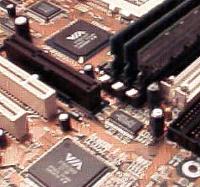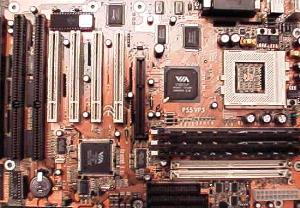Epox P55-VP3 Socket-7 Board
by Anand Lal Shimpi on April 17, 1998 8:32 PM EST- Posted in
- Motherboards
| Socket Style: | Socket-7 |
| Chipset: | VIA VP3 |
| Cache: | 512KB |
| Form Factor: | ATX |
| BUS Speeds: | 55 / 60 / 66 / 75 MHz |
| Clock Multipliers: | 1.5x / 2.0x / 2.5x / 3.0x / 3.5x / 4.0x / 4.5x / 5.0x |
| Voltages Supported: | 2.0v / 2.1v / 2.8v / 2.9v / 3.2v |
| RAM Slots: | 3 168pin DIMM
Slots (EDO/SDRAM) 2 72pin SIMM Slots (EDO/FPM) |
| AGP/PCI/ISA Slots: | 1 AGP Slot 4 PCI Slots 3 ISA Slots (1 Shared / 3 Full Length) |
| BIOS: | AWARD PnP BIOS |
| PCI EIDE Controller: | Super I/O 2 EIDE Channels 1 FDD Channel 2 Serial /1 EPP |
| One thing users noticed with the PA-2012 was the fact that the board was geared towards users interested in the ultimate high end system, therefore features such as ISA slots and SIMM sockets were all but left out of the design of the mainboard. This upset quite a few users who planned on re-using their ISA peripherals (which most of us still have) as well as their 72pin EDO SIMMs. EPoX, took a much different approach to their motherboard design with the P55-VP3, while meeting the requirements of the ATX specification they managed to fit in a spacious 3 ISA slots in addition to the 4 PCI and 1 AGP slot. You have just about every end covered with the 55-VP3, including memory expansion, unlike most newer LX motherboards as well as the few VP3 motherboards that have been popping up everywhere the P55-VP3 from EPoX features 3 DIMM slots as well as 2 72pin SIMM slots, so you are able to re-use your old EDO/FPM SIMMs if you desire to do so. How long will it take for manufacturers to understand that one of the key elements to a successful product is flexibility? I should mention that you are limited by the 6 RAS lines limit of the Apollo VP3 chipset, meaning the installed RAM can only occupy a maximum of 6 RAS lines (a double RAS SDRAM modules occupies 2 RAS lines, therefore using 1/3 of the theoretical 6 RAS line limit of the chipset). |  |
 |
The P55-VP3 uses the ATX form factor to the best of its ability...how? By using EPoX's own ESSJ function for CPU selection, otherwise known as Easy Setting Simple Jumper...nice name eh? All that means is that by using one easy to set jumper you can completely set the final CPU speed and by using another single jumper you can set the core voltage setting for your CPU. This is an interesting approach to a nearly jumperless motherboard solution, however for die hard overclockers this could prove to be more of a hindrance than a convenience. Supporting bus speeds ranging from 55MHz to a maximum frequency of 75MHz, the P55-VP3 is dead even with FIC's PA-2012 as far as possible bus speeds are concerned, however that ESSJ feature limits the highest achievable clock speed with today's CPU's to 233MHz (sorry guys, no 262.5MHz setting). The voltage possibilities with the P55-VP3 are also pretty limited due to the ESSJ function, however since you can't really accomplish much overclocking with this motherboard the highest setting of 3.2v is more than enough for any user. |
Packaged with the P55-VP3 is a wonderful set of useful accessories, some of which you can't do without, especially considering Windows 95 isn't pre-bundled with the drivers necessary to use VIA's VP3 chipset to its full potential. The package includes a fairly thorough manual, although it isn't anywhere near as complete as the manuals found packaged with ABIT and Chaintech motherboards EPoX's manual documents all the information necessary to get your computer up and running as soon as possible. The manual also documents a feature unique to the P55-VP3, the ability to turn on your system (when powered by an ATX PS Unit) from your keyboard. By depressing 1 or 2 keys for an extremely short period of time (1 to 2 seconds) you can completely power up the system without ever having to touch your case, combine this with the Soft-Off function of the ATX specification for Power Supply units and we have one very MAC-like combination. Something tells me that an auto-ejecting floppy drive is right around the corner (*shudder*), let's hope not =) Also bundled with the P55-VP3 are two VERY important disks, these disks are absolutely necessary for the proper operation of the VP3 motherboard. The two disks contain the VIA IDE Busmastering drivers as well as VIA's own GART VxD for AGP support on the P55-VP3. Those two drivers are probably the most difficult to find on the net as far as chipset related products go (if you so much as mention Aladdin IV drivers...hehe =)..).
The reliability of the P55-VP3 can be summed up in one of the most common words in our daily lives, average. We have average looking cars, average speed computers with average sized monitors, and we have a motherboard whose reliability is simply "average." Before I receive evil title for calling the new comer VP3 board "average" let me explain why. FIC's PA-2012 sparingly makes use of around 20 mid to oversized electrolytic capacitors, and is as solid as a rock at all possible clock speeds. The EPoX P55-VP3 protects you from overclocking by using that ESSJ function mentioned earlier, however even then don't expect the P55-VP3 to be the most reliable motherboard you've ever used. In normal operation the EPoX board will stand up against the competition, in overclocked operation the EPoX board will again, stand high against the competition, however in the long run, with your system on 24 hours a day 7 days a week, the P55-VP3 may begin to show signs of weakening. Seeing as very few people leave their computers on 24/7 doing extremely processor and I/O intensive operations the long term reliability and stability of the P55-VP3 shouldn't ever even have to come into consideration, however it is something to keep in mind when deciding between VP3 motherboards.
The performance of the P55-VP3 is also "average" for a Socket-7 board, although it can be easily beat by FIC's PA-2012 as well as some TX motherboard entries from various manufacturers. When you decide to go with a VP3 motherboard you are looking for features in overall decent motherboard, and that's exactly what you get with the P55-VP3.
Problems with the P55-VP3? There are just a few that must be mentioned...nothing major though
Not an overclocker's board, no Sanyo capacitors and the highest achievable clock speed is 233MHz
No 83.3MHz bus speed support
If you absolutely must have a VP3 board now, the EPoX P55-VP3 is a superb choice, it works flawlessly with pairs and triplets of SDRAM (benchmarks using 2 x 32MB & 1 x 64MB SDRAM DIMM below) and shouldn't provide you with many problems if any during the course of its lifetime.










0 Comments
View All Comments